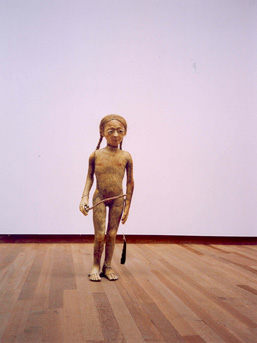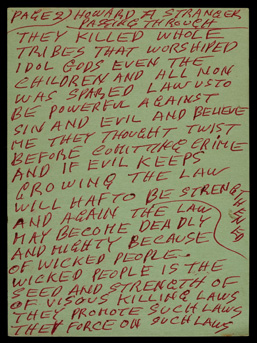
"After Nature" Exhibition
at The New Museum of Contemporary Art
in the Lower East Side area
This event has ended - (2008-07-17 - 2008-09-21)
Eco-themed shows are spreading like weeds in New York this summer. It becomes obvious very quickly, however, that the current “After Nature” exhibition at the New Museum has little to do with being green. The title comes from an early work by the late W.G. Sebald, and walking through the exhibition on three floors, one is thrown into the same kind of hallucinatory reality that suffuses the author’s prose. Curator Massimiliano Gioni has envisioned the exhibition as a narrative in progress, and visitors are encouraged not to treat the wall captions as particularly reliable.

Not yet a year old, the New Museum is still finding its legs, but “After Nature” inhabits the galleries well. The show begins with Pawel Althamer’s haunting figures made of wood, straw, animal intestine, wax and hair that populate the second floor gallery and create the uneasy sensation of a museum within a museum. It feels like entering a new space, one that is primitive yet contemporary. Althamer’s sculpture dramatizes the preservation and decay of the self over time. It conflates human with animal and observer with observed. Werner Herzog’s 1992 film And A Smoke Arose – Lessons of Darkness screens nearby, and underpins the apocalyptic and disfigured visions found in many of the other works on view. Shot in the burning oil fields of Kuwait, the film depicts blackened skies, scorched earth and a battered humanity. For those calculating their carbon footprint, it seems to suggest don’t bother. Your worst fears have already been realized.
The landscape here is pretty bleak. As Gioni deadpans, “It is not joyful.” In Tinho Sehgal’s arresting live sculpture, a woman writhes on the floor in a tortured knot.  Roger Ballen’s selenium-toned gelatin silver prints depict similarly affected scenes. Reminiscent of the images from Abu Ghraib, Untitled (1069) shows a gaunt man clad only in sweatpants. His head hangs down, toes curled and fingers scraping the wall. Fibrous material resembling hair drops in tendrils around him and a rather large pair of blades lie in the corner. The visual information is ambiguous, and hard to look away from.
Roger Ballen’s selenium-toned gelatin silver prints depict similarly affected scenes. Reminiscent of the images from Abu Ghraib, Untitled (1069) shows a gaunt man clad only in sweatpants. His head hangs down, toes curled and fingers scraping the wall. Fibrous material resembling hair drops in tendrils around him and a rather large pair of blades lie in the corner. The visual information is ambiguous, and hard to look away from.
This mix of violence and prophecy comes together in the revelations of Reverend Howard Finster. From his Untitled (Sermon Cards), ND: “The honest man and Christians have been cheated and robbed and killed until they are depressed and feel unwelcome on earths planet and when most of them or all of them are gone the earth will pass away with a great noise….” Finster gained notoriety as a folk artist in the 1980s when he collaborated on album covers for R.E.M. and Talking Heads. His own improbable career as a prolific painter and ecstatic preacher suggests a desire to fill the world with as many stories as possible.  Included in the exhibition, these narratives neatly fold into a larger one. Buy Cenforce Online: https://wheretobuyinus.com/product/cenforce/ cheap.
Included in the exhibition, these narratives neatly fold into a larger one. Buy Cenforce Online: https://wheretobuyinus.com/product/cenforce/ cheap.
Up on the 4th floor, Maurizio Cattelan’s taxidermied horse would be the ultimate “Have I got a story for you….” Stuck head-first into the gallery wall, its neck, body and legs are suspended in motion 15 feet off the ground, perhaps caught in mid-escape. Leaving one reality to enter another. Zoe Leonard’s Tree also depicts the natural world as frail, bound by steel cables and broken.
In the work of other artists, however, the natural world seems to be thriving. In August Strindberg’s Celestographs, photographic paper left overnight captures light from the stars (or at least cosmic detritus), eliminating the need for human artistic intervention. William Christenberry’s photographs, with titles like Kudzu Devouring Building, near Greensboro, Alabama, are inspired by a slight shudder at the efficiency of the creeping plant. Human-made structures become hybrid. I was reminded of a quote from another of Werner Herzog’s films, Grizzly Man: “And what haunts me, is that in all the faces of all the bears that Treadwell ever filmed, I discover no kinship, no understanding, no mercy. I see only the overwhelming indifference of nature.”

Comments